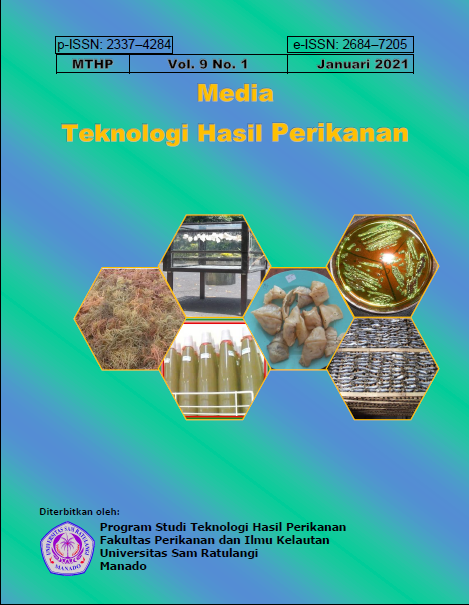ISOLASI SENYAWA SESQUITERPEN DARI FRAKSI AKTIF ANTIBAKTERI ALGA LAUT MERAH Laurencia tronoi
DOI:
https://doi.org/10.35800/mthp.9.1.2021.30679Keywords:
Laurencia tronoi, senyawa baru, sesquiterpenAbstract
The purpose of this study was to obtain new compounds isolated from the active antibacterial fraction, namely the hexane fraction of the red marine algae Laurencia tronoi, so that these marine algae can be developed as functional foods. The extraction method used was maceration with methanol-water 50%. The water methanol extract was continuously fractionated using n-hexane, ethyl acetate and water as solvents. The n-hexane fraction which has the highest antibacterial activity is then purified to obtain pure isolates using 3 steps column chromatography. Detection of the separation results at each stage was carried out using thin layer chromatography. The separation of stages 1 and 2 used a stationary phase of silica gel 60F254 and a mobile phase of hexane-ethylacetate, while the separation of the third stage used a stationary phase of silica gel 60F254 RP-18 and a mobile phase of water-methanol to obtain pure isolates. Structural characterization of pure isolates using the NMR spectroscopic method. The pure isolate produced is in the form of a white amorphous solid with the results of interpretation of the H-NMR, C-NMR, DEPT, HMQC, HMBC and COSY spectrum which is a sesquiterpene compound having the molecular formula C15H26O4 having the name IUPAC 3,3,9a-trimethyl-6-metylene-decahydro-1H-benzo [7] annulen-1,2,4a, 8-tetraol. This pure isolate is thought to be a new compound because basedÂ
Â
Tujuan penelitian ini adalah mendapatkan “senyawa baru yang diisolasi dari fraksi aktif  antibakteri yaitu fraksi heksana alga laut merah laurencia tronoi,  sehingga alga laut ini dapat dikembangkan sebagai pangan fungsionalâ€. Metode ekstraksi yang digunakan adalah maserasi dengan metanol-air 50%, pada ekstrak metanol air dilakukan fraksinasi berkesinambungan dengan menggunakan pelarut n-heksana, etilasetat dan air. Fraksi n-heksana yang mempunyai aktivitas antibakteri tertinggi selanjutnya dimurnikan untuk mendapatkan isolat murni dengan menggunakan kromatografi kolom sebanyak 3 tahap. Pendeteksian hasil pemisahan pada tiap tahap dilakukan dengan menggunakan kromatografi Lapis tipis. Pemisahan tahap 1 dan 2 menggunakan fasa diam silika gel 60F254 dan fasa gerak heksana-etilasetat, sedangkan pemisahan tahap ke-3 menggunakan fasa diam silika gel 60F254 RP-18 dan fasa gerak air-metanol hingga didapatkan isolat murni. Karakterisasi struktur isolat murni menggunakan metode spektrokopi NMR. Isolat murni yang dihasilkan berupa padatan amorf berwarna putih dengan hasil interpretasi terhadap spectrum H-NMR, C-NMR, DEPT, HMQC, HMBC dan COSY adalah termasuk golongan senyawa sesquiterpen mempunyai rumus molekul C15H26O4  mempunyai nama IUPAC 3,3,9a-trimetil-6-metilen-dekahidro-1H-benzo[7] annulen-1,2,4a,8-tetraol. Isolat murni ini diduga adalah senyawa baru karena berdasarkan penelusuran literatu belum ditemukan struktur yang sama dengan struktur isolat murni yang dihasilkan dalam penelitian ini.
References
Dawes C.J. 1998. Marine Botany. Second Edition. John Wiley and Sons, Inc
Dotulong V, Widjanarko S.B, Yunianta and Mamahit L.P. 2013. The Content of Total Phenol and Antoxidant Activity Three Types Sea Algae Taken at the North Sulawesi Waters. Food Science and Quality Management ISSN 2224-6088 (Paper) ISSN 2225-0557 (Online) www.iiste.org 40 Vol.17.
Dotulong V, Wonggo D, Montolalu L A. D. Y., Damongilala L. J. 2016. Potensi Antibakteri rumput laut Laurencia tronoi Asal Perairan Sulawesi Utara .Prociding Nasional MPHPI dan Pertemuan Ilmiah Tahunan Ke-8. Di Ambon, ISBN: 978-602-61551-0-8
Harborne. J. B. 2006. Metode Fitokimia. Penuntun Cara Modern Menganalisis Tumbuhan. Terbitan Kedua. Penerjemah:Kosasih padmawinata dan Iwang Soediro. Penyunting: Sofia Mansoor. ITB Bandung.
Santos A.O.D, P.V. Santos , Tânia, Ueda-Nakamura T.U, B. P. D. Filho, Sudatti D. B, É. M Bianco , Pereira . R. C, and C V Nakamura. 2010. Effect of Elatol, Isolated from Red Seaweed Laurencia dendroidea, on Leishmania amazonensis. Mar. Drugs 2010, 8, 2733-2743.
Shui-Chun M, and G. Yue-Wei. 2010. Sesquiterpenes from Chinese Red Alga Laurencia okamurai. Chinese Journal of Natural Medicines 8(5): 0321−0325
Soepratman. 2010. Elusidasi Struktur Senyawa Organik. FMIPA Universitas Pajajaran. Bandung
Su H, D.Y. Si, J. Li, S.Y.Cuo, Lili,L, Z.H, Yuan, and Binzhu, X. 2009. Sesquiterpen From Laurencia cimilis. Molecules 14(1889-1897) ISSN 1420-3049.
Trono 1988. Philipine Seaweed. Philipine National Book Store Inc Pub Metro. Manila
Yun Ji. N , X. Ming Li, and Gui Wang. B. 2008. Halogenated Terpenes and a C15-Acetogenin from the Marine Red Alga Laurencia saitoi. Molecules 13, 2894-2899.
.
Downloads
Published
How to Cite
Issue
Section
License
Authors who publish with this journal agree to the following terms:
- Authors retain copyright and grant the journal right of first publication with the work simultaneously licensed under a Creative Commons Attribution License that allows others to share the work with an acknowledgement of the work's authorship and initial publication in this journal.
- Authors are able to enter into separate, additional contractual arrangements for the non-exclusive distribution of the journal's published version of the work (e.g., post it to an institutional repository or publish it in a book), with an acknowledgement of its initial publication in this journal.
- Authors are permitted and encouraged to post their work online (e.g., in institutional repositories or on their website) prior to and during the submission process, as it can lead to productive exchanges, as well as earlier and greater citation of published work (See The Effect of Open Access).







